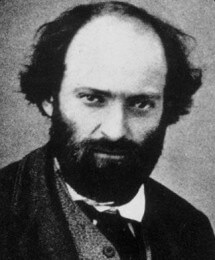Therapeutic Benefits of Art
Paul Cézanne famously wrote: “Don’t be an art critic, but paint, there lies salvation.” The radical Post-Impressionist imparted these words decades before modern psychology, mental welfare, and [...]

1838–1906
French artist Paul Cézanne was a highly influential figure in 20th century art, a pioneer in the Post-Impressionist movement, and inspiration for the Cubist movement. Cézanne was born on January 19, 1839 in Aix-en-Provence, France. His father, Louis-Auguste Cézanne, the co-founder of a highly successful banking firm, discouraged his son from pursuing his interest in art and persuaded him to study law instead. Wishing to please his father, yet not wanting to abandon his dream of becoming an artist, Cézanne studied law at University of Aix, but also enrolled and took courses at the School of Design at Aix at the same time. In 1861, Cézanne expressed his wish to move to Paris and pursue a career as an artist to his father, who eventually acquiesced and financed his son’s living expenses.
Cézanne’s rise to prominence in the art world was not an immediate one. He experienced a great deal of self-doubt early on, fueled in part by a rejection from the École des Beaux Arts. He stayed in Paris less than a year before returning home to Aix and tried his hand working at his father’s business. He moved back to Paris to reattempt a career in art in 1862. During this time he met Impressionist artist Camille Pissarro, who would become an influential figure in his life.
In 1869, Cézanne met Hortense Fiquet, who modeled for him and would later become his wife. In 1872, Cézanne moved with Fiquet and their son, Paul, to Pontoise, a suburb about 18 miles outside of Paris. Pontoise was also home to Camille Pissarro. Pissarro and Cézanne painted extensively together for the next two years, painting landscapes in the Impressionist style. In 1874, Cézanne’s work was included in the first exhibition of Impressionist works, the Société Anonyme des Artistes Peintres, Sculpteurs et Graveurs. Cézanne’s work, as with many of the other Impressionists (the name “Impressionists” originally used as a derogatory term, coined by art critic Louis Leroy) had been rejected consistently by the official Paris Salons.
Cézanne participated in only one other Impressionist exhibition, in 1877. He questioned the lack of structure that was synonymous with Impressionist works. “I want to make of Impressionism something solid and lasting like the art in the museums,” he said. He began to seek subjects with a geometric structure and concentrated on the representation of spatial relationships and forms rather than the Impressionist focus on the depiction of light. “Treat nature by means of the cylinder, the sphere, the cone,” he said. These concepts would later form the building blocks of Cubism.
Cézanne explored these ideas in the landscapes and still lifes he created during the 1880s. At the suggestion of Pissarro, preeminent art dealer Ambroise Vollard presented Cézanne’s first one-man exhibition in 1895 – the first public exhibition of his work in Paris in 20 years – which sparked the artist’s first positive widespread reception from the public. His work was accepted and exhibited in the annual Salon des Indépendents in 1899, 1901, and 1902. In 1904, the entire room of the Salon d’Automne was dedicated to his work.
Later in life, Cézanne and his family returned to his hometown of Aix-en-Provence. Despite his deteriorating health Cézanne continued to work, using a studio he built at Chemin des Lauves outside of Aix. While he typically took a carriage from his home to his studio, a sudden increase in the fare prompted him to make the trip by foot one day. He was caught in a downpour and developed pneumonia. Paul Cézanne died a week later, on October 22, 1906.
Cézanne’s legacy in the art world remains firmly in place to this day, furthering the Impressionist movement and sparking the Post-Impressionist and Cubist movements. Pablo Picasso, who became a leader of the Cubist movement, called Cézanne “the father of us all.” Cézanne’s work is exhibited in the top public and private collections around the world.
for breaking news, artist updates, and special sale offers